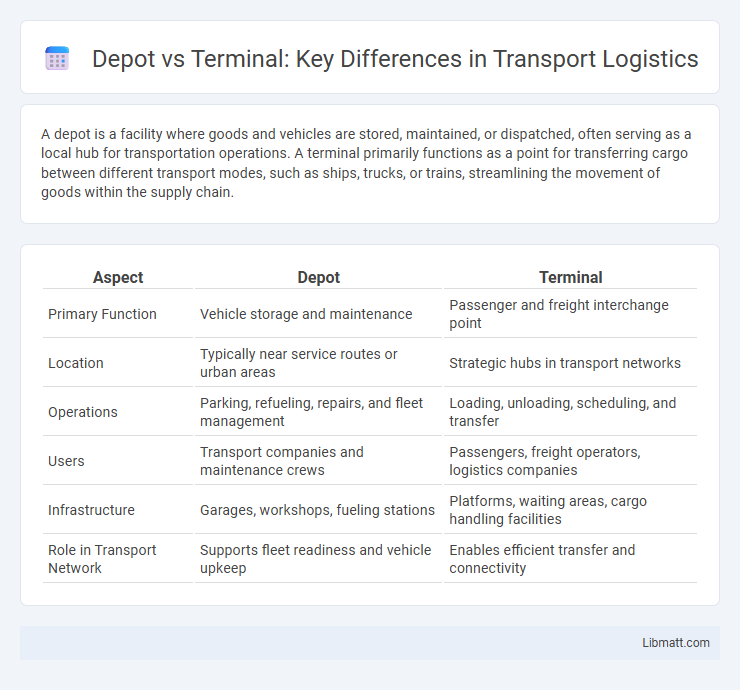A depot is a facility where goods and vehicles are stored, maintained, or dispatched, often serving as a local hub for transportation operations. A terminal primarily functions as a point for transferring cargo between different transport modes, such as ships, trucks, or trains, streamlining the movement of goods within the supply chain.
Table of Comparison
| Aspect | Depot | Terminal |
|---|---|---|
| Primary Function | Vehicle storage and maintenance | Passenger and freight interchange point |
| Location | Typically near service routes or urban areas | Strategic hubs in transport networks |
| Operations | Parking, refueling, repairs, and fleet management | Loading, unloading, scheduling, and transfer |
| Users | Transport companies and maintenance crews | Passengers, freight operators, logistics companies |
| Infrastructure | Garages, workshops, fueling stations | Platforms, waiting areas, cargo handling facilities |
| Role in Transport Network | Supports fleet readiness and vehicle upkeep | Enables efficient transfer and connectivity |
Introduction to Depot and Terminal
A depot serves as a centralized location for storing goods, equipment, or vehicles, facilitating efficient inventory management and distribution. Terminals function as transfer points where cargo or passengers are loaded, unloaded, and often consolidated between different transportation modes. Both depots and terminals are critical infrastructure components in logistics and supply chain operations, optimizing the flow and storage of goods.
Definition of Depot
A depot serves as a centralized facility where goods, vehicles, or equipment are stored and maintained before distribution or deployment. It functions as a hub for inventory management, ensuring efficient organization and readiness of resources. Unlike terminals, depots primarily focus on storage and upkeep rather than being points of transit or transfer.
Definition of Terminal
A terminal is a centralized facility where cargo is received, sorted, and transferred for onward transportation, often serving as a key node in logistics networks. It functions as a hub for loading and unloading containers, trucks, or trains, facilitating efficient goods movement across supply chains. Your shipments are processed through terminals to ensure timely distribution and coordination between different transport modes.
Key Differences Between Depot and Terminal
A depot primarily functions as a storage facility for goods, vehicles, or fuel, typically designed for long-term holding and operational maintenance. Terminals serve as critical transfer points where cargo is loaded, unloaded, sorted, or redistributed between transportation modes like trucks, ships, or trains. The key distinctions lie in depots being storage-centric with maintenance capabilities, while terminals emphasize logistics and freight handling for efficient transit management.
Functions of a Depot
A depot functions as a centralized facility for storing, maintaining, and dispatching transportation vehicles, ensuring efficient fleet management and operational readiness. It serves as a hub for routine inspections, repairs, fueling, and scheduling, helping to minimize downtime and optimize vehicle utilization. Depots also facilitate inventory control of spare parts and manage driver assignments to streamline logistics and transportation workflows.
Functions of a Terminal
A terminal serves as a critical logistics hub where cargo is efficiently transferred between different modes of transportation, such as ships, trucks, and trains. It functions to facilitate container storage, customs clearance, and cargo inspection, ensuring seamless handling and distribution within the supply chain. Terminals also provide value-added services like packaging, labeling, and inventory management to optimize freight flow and reduce transit times.
Types of Depots
Depots vary widely based on their functions, including distribution depots for goods storage and dispatch, service depots that handle vehicle maintenance and repairs, and rail depots dedicated to train storage and scheduling. Each type of depot plays a critical role in supply chain efficiency and transportation management. Understanding the specific type of depot relevant to Your operations can optimize logistics and maintenance planning.
Types of Terminals
Terminals come in various types, including container terminals, bulk terminals, and liquid terminals, each designed to handle specific cargo efficiently. Container terminals focus on managing standardized shipping containers with cranes and storage yards, while bulk terminals specialize in loose materials like coal, grain, or minerals using conveyors and silos. Liquid terminals are equipped to store and transfer petroleum, chemicals, or other liquids through tanks and pipelines, ensuring your cargo is processed safely and accurately.
Factors to Consider When Choosing Between Depot and Terminal
When choosing between a depot and a terminal, consider factors such as location accessibility, operational capacity, and the specific logistics needs of your business. Depots typically offer localized storage and quicker handling times, making them ideal for distribution in concentrated areas, while terminals provide larger-scale ports for extensive shipment transfer and international freight. Your decision should align with your supply chain priorities, including cost efficiency, turnaround time, and connectivity to transportation networks.
Conclusion: Depot vs Terminal
Depots primarily serve as storage and maintenance facilities for vehicles or goods, while terminals function as hubs for loading, unloading, and transferring shipments between transportation modes. Depots optimize fleet readiness and inventory management, whereas terminals enhance logistical efficiency through streamlined cargo handling and distribution. Selecting between a depot and terminal depends on operational priorities, with depots suited for long-term storage and upkeep, and terminals designed for active transportation and cargo movement.
depot vs terminal Infographic

 libmatt.com
libmatt.com